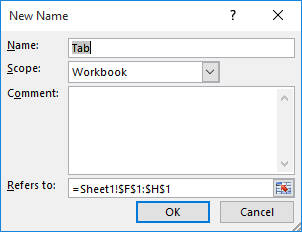Please Note: This article is written for users of the following Microsoft Excel versions: 2007, 2010, 2013, 2016, 2019, 2021, and Excel in Microsoft 365. If you are using an earlier version (Excel 2003 or earlier), this tip may not work for you. For a version of this tip written specifically for earlier versions of Excel, click here: Non-adjusting References in Formulas.
Written by Allen Wyatt (last updated July 23, 2022)
This tip applies to Excel 2007, 2010, 2013, 2016, 2019, 2021, and Excel in Microsoft 365
Everybody knows you can enter a formula in Excel. (What would a spreadsheet be without formulas, after all?) If you use address references in a formula, those references are automatically updated if you insert or delete cells, rows, or columns and those changes affect the address reference in some way. Consider, for example, the following simple formula:
=IF(A7=B7,"YES","NO")
If you insert a cell above B7, then the formula is automatically adjusted by Excel so that it appears like this:
=IF(A7=B8,"YES","NO")
What if you don't want Excel to adjust the formula, however? You might try adding some dollar signs to the address, but this only affects addresses in formulas that are later copied; it doesn't affect the formula itself if you insert or delete cells that affect the formula.
The best way to make the formula references "non-adjusting" is to modify the formula itself to use different worksheet functions. For instance, you could use this formula in cell C7:
=IF(INDIRECT("A"&ROW(C7))=INDIRECT("B"&ROW(C7)),"YES","NO")
This formula constructs an address based on whatever cell the formula appears in. The ROW function returns the row number of the cell (C7 in this case, so the returned value is 7) and then the INDIRECT function is used to reference the constructed address, such as A7 and B7. If you insert (or delete) cells above A7 or B7, the reference in cell C7 is not disturbed, as it just blithely constructs a brand new address.
Another approach is to use the OFFSET function to construct a similar type of reference:
=IF(OFFSET($A$1,ROW()-1,0)=OFFSET($B$1,ROW()-1,0),"YES","NO")
This formula simply looks at where it is (in column C) and compares the values in the cells that are to its left. This formula is similarly undisturbed if you happen to insert or delete cells in either column A or B.
A final approach (and perhaps the slickest one) is to use named formulas. This is a feature of Excel's naming capabilities that is rarely used by most people. Follow these steps:

Figure 1. The New Name dialog box.
=IF(A2=B2,"YES","NO")
At this point you've created your named formula. You can now use it in any cell in column C in this manner:
=CompareMe
It compares whatever is in the two cells to its left, just as your original formula was designed to do. Better still, the formula is not automatically adjusted as you insert or delete cells.
ExcelTips is your source for cost-effective Microsoft Excel training. This tip (12348) applies to Microsoft Excel 2007, 2010, 2013, 2016, 2019, 2021, and Excel in Microsoft 365. You can find a version of this tip for the older menu interface of Excel here: Non-adjusting References in Formulas.

Dive Deep into Macros! Make Excel do things you thought were impossible, discover techniques you won't find anywhere else, and create powerful automated reports. Bill Jelen and Tracy Syrstad help you instantly visualize information to make it actionable. You’ll find step-by-step instructions, real-world case studies, and 50 workbooks packed with examples and solutions. Check out Microsoft Excel 2019 VBA and Macros today!
Excel can be used to generate random testing data that you can use in any way you deem necessary. This tip provides ...
Discover MoreDo you need to figure out the rightmost value within a row in which not all cells may contain values? This tip provides a ...
Discover MoreThe FIND and SEARCH functions are great for finding the initial occurrence of a character in a text string, but what if ...
Discover MoreFREE SERVICE: Get tips like this every week in ExcelTips, a free productivity newsletter. Enter your address and click "Subscribe."
2022-07-26 14:50:02
J. Woolley
The Tip's CompareMe named formula with Workbook scope is clever but problematic because it is tied to the worksheet cell that was active when CompareMe was defined. For example, if Sheet1!C2 is active when CompareMe is defined as
=IF(A2=B2,"YES","NO")
the definition will immediately be changed to
=IF(Sheet1!A2=Sheet1!B2,"YES","NO")
Then if CompareMe is used in column C of Sheet2 its result will depend on the content of columns A and B on Sheet1 instead of Sheet2. This problem is mitigated when CompareMe is defined with Sheet1 scope; in this case, using CompareMe on Sheet2 will result in a #NAME? error.
It should also be noted that if Sheet1!C1 was active when CompareMe was defined as
=IF(A2=B2,"YES","NO")
then CompareMe will always compare cells that are in the next row (the row below).
For a better definition of CompareMe with Workbook scope which is not tied to the active worksheet cell, try this:
=IF(INDIRECT("R[0]C[-2]",FALSE)=INDIRECT("R[0]C[-1]",FALSE),"YES","NO")
In this case, CompareMe can be used on any sheet. (But be aware that INDIRECT is a Volatile function like OFFSET or NOW.)
It is worth noting that either version of CompareMe can also be used in column D to compare cells in columns B and C or in column E to compare cells in columns C and D; therefore, a better name might be AreTheLeftTwoCellsEqual.
Got a version of Excel that uses the ribbon interface (Excel 2007 or later)? This site is for you! If you use an earlier version of Excel, visit our ExcelTips site focusing on the menu interface.
FREE SERVICE: Get tips like this every week in ExcelTips, a free productivity newsletter. Enter your address and click "Subscribe."
Copyright © 2026 Sharon Parq Associates, Inc.
Comments